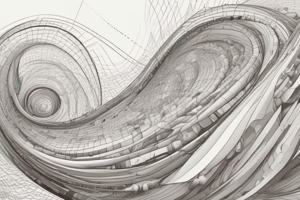Podcast
Questions and Answers
What is the primary use of differentiation in calculus?
What is the primary use of differentiation in calculus?
- To study the behavior of functions (correct)
- To solve algebraic equations
- To graph functions
- To find the area under curves
What does the derivative of a function at a point represent?
What does the derivative of a function at a point represent?
- The slope of the function at that point
- The intercept of the function at that point
- The rate of change of the function at that point (correct)
- The maximum value of the function
What is the formula for the derivative of f(x) = x^n?
What is the formula for the derivative of f(x) = x^n?
- f'(x) = x^(n-1)
- f'(x) = nx^(n+1)
- f'(x) = 2x^(n-1)
- f'(x) = nx^(n-1) (correct)
What is the formula for the derivative of f(x) = u(x)v(x) using the Product Rule?
What is the formula for the derivative of f(x) = u(x)v(x) using the Product Rule?
What does the second derivative of a function represent?
What does the second derivative of a function represent?
Which application of differentiation is used to model the motion of objects?
Which application of differentiation is used to model the motion of objects?
What is the notation for the derivative of a function f(x)?
What is the notation for the derivative of a function f(x)?
What is the purpose of the Chain Rule in differentiation?
What is the purpose of the Chain Rule in differentiation?
What is the name of the rule used to find the derivative of a function f(x) = u(x)/v(x)?
What is the name of the rule used to find the derivative of a function f(x) = u(x)/v(x)?
What is the application of differentiation in economics?
What is the application of differentiation in economics?
Flashcards are hidden until you start studying
Study Notes
Differentiation
Definition
- Differentiation is a mathematical operation that finds the rate of change of a function with respect to one of its variables.
- It is a fundamental concept in calculus, used to study the behavior of functions, optimize functions, and solve problems in physics, engineering, and other fields.
Geometric Interpretation
- The derivative of a function at a point represents the slope of the tangent line to the graph of the function at that point.
- The derivative can be visualized as the rate of change of the function with respect to the input variable.
Rules of Differentiation
- Power Rule: If f(x) = x^n, then f'(x) = nx^(n-1)
- Product Rule: If f(x) = u(x)v(x), then f'(x) = u'(x)v(x) + u(x)v'(x)
- Quotient Rule: If f(x) = u(x)/v(x), then f'(x) = (u'(x)v(x) - u(x)v'(x)) / v(x)^2
- Chain Rule: If f(x) = g(h(x)), then f'(x) = g'(h(x)) * h'(x)
Higher-Order Derivatives
- The second derivative of a function represents the rate of change of the first derivative.
- Higher-order derivatives can be used to study the concavity and inflection points of a function.
Applications of Differentiation
- Optimization: Differentiation is used to find the maximum or minimum of a function.
- Physics: Differentiation is used to model the motion of objects, including acceleration and velocity.
- Economics: Differentiation is used to model economic systems, including supply and demand curves.
Notation
- The derivative of a function f(x) is denoted as f'(x) or (d/dx)f(x).
- The second derivative of a function f(x) is denoted as f''(x) or (d^2/dx^2)f(x).
Differentiation
Definition and Purpose
- Differentiation is a mathematical operation to find a function's rate of change with respect to one of its variables.
- It's a fundamental concept in calculus, used to study function behavior, optimize functions, and solve physics, engineering, and other field problems.
Geometric Interpretation
- The derivative of a function at a point represents the slope of the tangent line to the graph of the function at that point.
- It can be visualized as the rate of change of the function with respect to the input variable.
Rules of Differentiation
- Power Rule: If f(x) = x^n, then f'(x) = nx^(n-1).
- Product Rule: If f(x) = u(x)v(x), then f'(x) = u'(x)v(x) + u(x)v'(x).
- Quotient Rule: If f(x) = u(x)/v(x), then f'(x) = (u'(x)v(x) - u(x)v'(x)) / v(x)^2.
- Chain Rule: If f(x) = g(h(x)), then f'(x) = g'(h(x)) * h'(x).
Higher-Order Derivatives
- The second derivative of a function represents the rate of change of the first derivative.
- Higher-order derivatives are used to study a function's concavity and inflection points.
Applications of Differentiation
- Optimization: Differentiation helps find a function's maximum or minimum.
- Physics: Differentiation models object motion, including acceleration and velocity.
- Economics: Differentiation models economic systems, including supply and demand curves.
Notation
- The derivative of a function f(x) is denoted as f'(x) or (d/dx)f(x).
- The second derivative of a function f(x) is denoted as f''(x) or (d^2/dx^2)f(x).
Studying That Suits You
Use AI to generate personalized quizzes and flashcards to suit your learning preferences.




